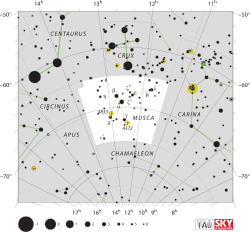- Musca
-
Musca Constellation 
List of stars in MuscaAbbreviation Mus Genitive Muscae Pronunciation /ˈmʌskə/, genitive /ˈmʌsiː/ Symbolism the Fly Right ascension 12.456 h Declination −70.341° Quadrant SQ3 Area 138 sq. deg. (77th) Main stars 6 Bayer/Flamsteed
stars13 Stars with planets 1 Stars brighter than 3.00m 1 Stars within 10.00 pc (32.62 ly) 1 Brightest star α Mus (2.69m) Nearest star Gliese 440
(15.07 ly, 4.62 pc)Messier objects none Meteor showers ?????
?????Bordering
constellationsApus
Carina
Centaurus
Chamaeleon
Circinus
CruxVisible at latitudes between +10° and −90°.
Best visible at 21:00 (9 p.m.) during the month of May.Musca (Latin: fly) is one of the minor southern constellations. The constellation was one of twelve constellations created by Petrus Plancius from the observations of Pieter Dirkszoon Keyser and Frederick de Houtman and it first appeared on a 35-cm diameter celestial globe published in 1597 (or 1598) in Amsterdam by Petrus Plancius and Jodocus Hondius. The first depiction of this constellation in a celestial atlas was in Johann Bayer's Uranometria of 1603.
Contents
Notable objects
The soft X-ray transient Nova Muscae 1991 is a binary object consisting of a star and a black hole. During the 1991 outburst which led to its discovery, radiation was produced through a process of positron annihilation. Musca also contains the unusual planetary nebula NGC 5189, located about 3,000 light years from earth. Its uniquely complex structure resembles a miniature crab nebula. Also within the constellation is the Hourglass Nebula (MyCn 18) at a distance of about 8,000 light years. The comparatively old globular cluster NGC 4833 near Delta Muscae is 21,200 light years distant and somewhat obscured by dust clouds near the galactic plane. The globular cluster NGC 4372 near Gamma Muscae is fainter and likewise partially obscured by dust, but spans more arc minutes.
History
Musca, under its original name Apis – the Bee, was introduced in the late 16th century by Petrus Plancius to fill the previously uncharted area around the southern pole and to provide nourishment for the nearby constellation Chamaeleon (17th-century celestial maps clearly show the chameleon's tongue trying to catch the insect). In 1752 Nicolas Louis de Lacaille renamed it to Musca Australis, the Southern Fly – Australis, since it counterparted the now discarded constellation of Musca Borealis composed of a few stars in Aries, and to avoid confusion with Apus. Today the name is simply Musca.[1]
Citations
References
- Ian Ridpath and Wil Tirion (2007). Stars and Planets Guide, Collins, London. ISBN 978-0007251209. Princeton University Press, Princeton. ISBN 978-0691135564.
- Thomas Wm. Hamilton, Useful Star Names, Holbrook, NY, Viewlex, 1968.
External links
- The Deep Photographic Guide to the Constellations: Musca
- Starry Night Photography: Musca
- Star Tales – Musca
Nearby Other HD 111232 (b)Other objects Andromeda · Antlia · Apus · Aquarius · Aquila · Ara · Aries · Auriga · Boötes · Caelum · Camelopardalis · Cancer · Canes Venatici · Canis Major · Canis Minor · Capricornus · Carina · Cassiopeia · Centaurus · Cepheus · Cetus · Chamaeleon · Circinus · Columba · Coma Berenices · Corona Australis · Corona Borealis · Corvus · Crater · Crux · Cygnus · Delphinus · Dorado · Draco · Equuleus · Eridanus · Fornax · Gemini · Grus · Hercules · Horologium · Hydra · Hydrus · Indus · Lacerta · Leo · Leo Minor · Lepus · Libra · Lupus · Lynx · Lyra · Mensa · Microscopium · Monoceros · Musca · Norma · Octans · Ophiuchus · Orion · Pavo · Pegasus · Perseus · Phoenix · Pictor · Pisces · Piscis Austrinus · Puppis · Pyxis · Reticulum · Sagitta · Sagittarius · Scorpius · Sculptor · Scutum · Serpens · Sextans · Taurus · Telescopium · Triangulum · Triangulum Australe · Tucana · Ursa Major · Ursa Minor · Vela · Virgo · Volans · VulpeculaCategories:- Musca constellation
- Constellations
- Southern constellations
- Western constellations
Wikimedia Foundation. 2010.
